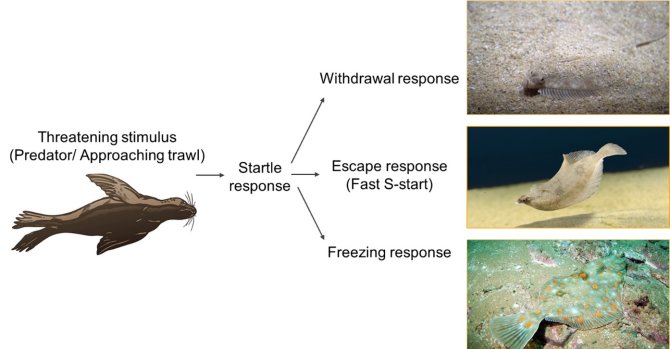
Project
Development of new stimulation techniques for flatfish trawling
We study the behaviour of flatfish to develop alternative stimulation techniques to tickler chains.
PI: Johan van Leeuwen
Sole (Solea solea) and Plaice (Pleuronectes platessa) are two commercially targeted flatfish species by means of beam trawl fishing gear in the North Sea. The gear consists of tickler chains and chain matts which maintain contact with the seabed thereby disturbing the fish out of the sediment and into the net but leading to heavy seabed disturbance and altering the benthic ecosystem composition. Furthermore, the technique has numerous shortcomings including high disturbance of benthic communities, high operating costs due to the high drag of the chains and rising fuel costs, low selectivity, and high mortality to undersized targeted and non-target fish.
This study aims to analyse the behaviour of the flatfish to develop alternative stimulation techniques to tickler chains and chain mats. These alternatives should have low hydrodynamic resistance, be economically viable, and have minimal ecological impact. The novel techniques should use a combination of stimuli that avoids burrowing and encourages swimming towards the net, thereby improving the capture efficiency.
To achieve this, the study is divided into three main components:
1) Swimming endurance:
Currently, the towing speeds of vessels with tickler chains are not optimized for the attainable swimming speed and endurance of the target flatfish species. Greater fundamental insight into flatfish endurance and swimming mechanism is therefore needed to provide better estimates of minimal required trawling speeds, which in turn could reduce fuel costs but maintain catch efficacy.
2a) Burrowing ability:
Burrowing is a typical behaviour of most flatfish with their flattened bodies and camouflage patterns helping them blend in with the sandy substrate. However, once dug into the seabed sediment they become difficult to access with conventional fishing gear. Literature regarding the true burial ability of the fish has remained relatively unexplored. This study will therefore use novel methods to determine the burial depth using non-invasive and unobtrusive techniques.

2b) Fast start escape response:
epending on environmental conditions flatfish react differently to threatening stimuli (Fig 1). The fast-start escape response is a form of unsteady swimming initiated by the simultaneous activation of muscles along one side of the body. Although the fast start is often referred to as an escape behaviour it can also be utilized during predatory strikes. Here, this study will quantify the biomechanics of the fast start response using high-speed footage.
3) Selected stimuli:
A large knowledge gap exists regarding the sensitivity of flatfish to various stimuli (electrical, light, sound, mechanical) and the threshold for triggering a response. This study will determine the detectability of various stimuli by flatfish and determine which combination of stimuli can be leveraged to provoke a fast-start swimming response while inhibiting burrowing, and controlling the fish’s swimming direction.
This project is working in collaboration with Delft University of Technology (TU Delft) and financed by TTW/NWO.
If you are interested in my project and would perhaps like to do a Master / Bachelor thesis with me, do not hesitate to contact me or via ezo.thesis@wur.nl.